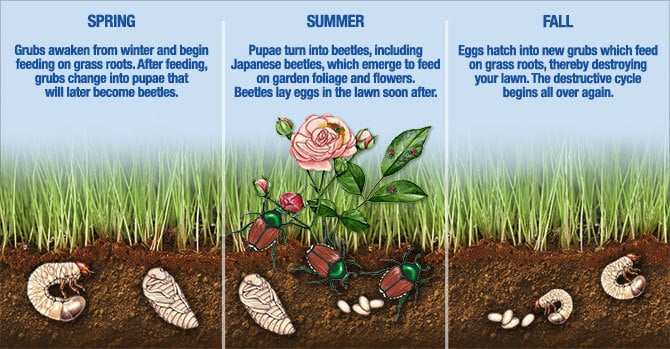While white grubs in lawn can be one of the most devastating and difficult invasions a yard can experience. Grub control for lawns can be a challenge, but with professional help like that of Lush Lawn, you don’t have to say goodbye to your beautiful, green grass. Learning how to diagnose, treat, and prevent grub infestations is an important part of proper landscaping management. With a variety of grub types available, from June bugs to billbugs, to more exotically sourced insects like the European chafer and the Japanese beetle, there is always a risk of one making your yard their new home.
Signs of Grubs
One of the most important factors for grub control lawn care is early detection. Brown patches that never grow new grass can be a sign that grubs were there in a past season. In a frequently watered lawn, the soil taking on a spongy character can be another sign that there are grubs dwelling underground. Sometimes this sponginess can be detected before wilting or death of grass begins to occur. Digging up a small cross-section of the lawn and checking for how many grubs you see is one of the best ways to diagnose your yard. Since the presence of some grubs is natural and in fact beneficial, you should only treat the yard if there is a high quantity. A high quantity of beetles in the area in the summer can also indicate high grub numbers in the spring and fall.
Synthetic Methods
There is a range of options when selecting a lawn grub treatment. If you are dealing with Japanese beetle grubs, there is a granular milky spore mix available that will target them directly. This is a disease spread by spores that will kill, and prevent, Japanese beetle grubs for a few years. Other types of grubs are not as affected, which means a more broad-spectrum synthetic could be better serving. Two main synthetics can be used to quickly eradicate grub populations of any stages. Choosing between carbaryl and trichlorfon should be done with the help of a knowledgeable lawn care professional, since depending on your specific yard one or the other may have positive or negative outcomes. Since there are so many natural remedies available for grub problems, synthetic additives should be a backup plan.
Manual Methods
There are many natural or manual options for lawn grub control. Lawn aeration tools with longer spikes can pierce and slay underground grubs. A few passes with aeration shoes or a deep-spiking tool can clear a yard in a short time. Another natural solution is the addition of insect parasitic nematodes to the environment. The nematodes will infect and devour certain grub species. While this method is synthetic free, introducing new parasites to your yard’s environment could have extra side effects. Heavy, regular watering can be useful for stopping the spread of grubs and drowning out some of the existing ones.
Future Prevention
Maintaining a healthy lawn is key to preventing the spread of grubs in your lawn. Regular fertilization is important to strengthen the grass and other foliage. Aerating the soil is another effective way to reduce grub infestations. The beetles that spawn the most destructive grubs prefer compacted soil for their eggs. Aerating the soil is beneficial for the turf in many ways, but in areas with a higher risk for grubs, it is crucial. There are preventative insecticides that can be used in the spring to keep your yard protected throughout the warm seasons. Not only can the experts at Lush Lawn help you remove existing grub infections, among other issues, but they can also help build a plan of attack to guard your yard against future problems.
